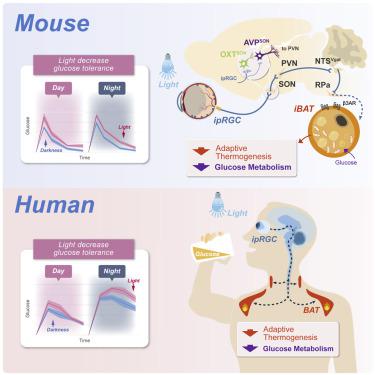Cell ( IF 45.5 ) Pub Date : 2023-01-19 , DOI: 10.1016/j.cell.2022.12.024 Jian-Jun Meng 1 , Jia-Wei Shen 1 , Guang Li 1 , Chang-Jie Ouyang 1 , Jia-Xi Hu 1 , Zi-Shuo Li 1 , Hang Zhao 1 , Yi-Ming Shi 1 , Mei Zhang 1 , Rong Liu 1 , Ju-Tao Chen 1 , Yu-Qian Ma 1 , Huan Zhao 2 , Tian Xue 3

|
Public health studies indicate that artificial light is a high-risk factor for metabolic disorders. However, the neural mechanism underlying metabolic modulation by light remains elusive. Here, we found that light can acutely decrease glucose tolerance (GT) in mice by activation of intrinsically photosensitive retinal ganglion cells (ipRGCs) innervating the hypothalamic supraoptic nucleus (SON). Vasopressin neurons in the SON project to the paraventricular nucleus, then to the GABAergic neurons in the solitary tract nucleus, and eventually to brown adipose tissue (BAT). Light activation of this neural circuit directly blocks adaptive thermogenesis in BAT, thereby decreasing GT. In humans, light also modulates GT at the temperature where BAT is active. Thus, our work unveils a retina-SON-BAT axis that mediates the effect of light on glucose metabolism, which may explain the connection between artificial light and metabolic dysregulation, suggesting a potential prevention and treatment strategy for managing glucose metabolic disorders.
中文翻译:

光通过视网膜-下丘脑-棕色脂肪组织轴调节葡萄糖代谢
公共卫生研究表明,人造光是代谢紊乱的高危因素。然而,光调节代谢的神经机制仍然难以捉摸。在这里,我们发现光可以通过激活支配下丘脑视上核(SON)的固有光敏视网膜神经节细胞(ipRGC)来急剧降低小鼠的葡萄糖耐量(GT)。SON 中的加压素神经元投射到室旁核,然后投射到孤束核中的 GABA 能神经元,最后投射到棕色脂肪组织 (BAT)。该神经回路的光激活直接阻断 BAT 中的适应性生热作用,从而降低 GT。在人类中,光也会在 BAT 活跃的温度下调节 GT。因此,我们的工作揭示了介导光对葡萄糖代谢影响的视网膜-SON-BAT轴,这可能解释了人造光与代谢失调之间的联系,并提出了管理葡萄糖代谢紊乱的潜在预防和治疗策略。









































 京公网安备 11010802027423号
京公网安备 11010802027423号